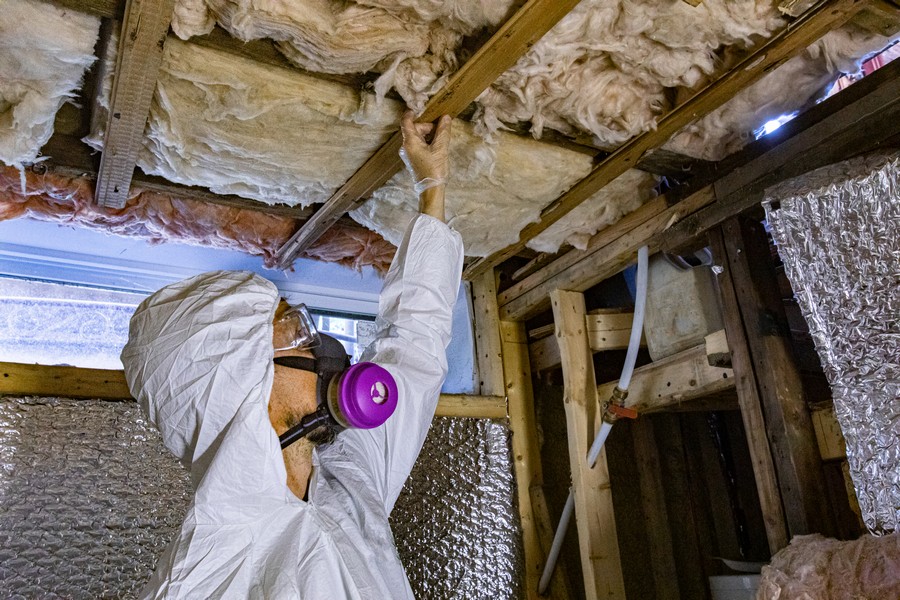What’s Dry Rot?
Dry rot is a type of wood degradation caused by a wood-destroying fungus that consumes the components of the wood that give it strength and stiffness. It was once used to characterise any fungus-caused rot of cured wood in ships and buildings, resulting in a darkly coloured, degraded, and cracked state.
The dry rot fungus’ life cycle can be broken down into four parts. Dry rot starts as a minute spore that can resemble fine orange dust in high enough quantities. If the dry rot spores are exposed to enough moisture, fine white strands known as hyphae will form. The hyphae will eventually form a huge mass known as mycelium as they germinate.
A fruiting body is an ultimate step, which releases fresh spores into the surrounding air.
Dry rot requires around 20% moisture content in the wood to begin growing. Dry rot, contrary to its name, does not thrive in dry environments.
Dry rot is common in homes with excessive humidity and inadequate ventilation. The windows are one early warning indication. If you reside in a very damp or humid environment, ensure your home is well ventilated to avoid moisture build-up.
Moisture can come through a leak, just as it might from damp rot. In either situation, identifying and removing the source of the humidity is critical before treating the fungus.
Dry rot is commonly found behind a wall or under floorboards, where it is hidden from view. It can cause significant damage to wood and spread throughout the house if it is not detected early on.
While fungicides can be used to treat dry rot, it’s always a good idea to have a surveyor analyse the full extent of the damage. To investigate, it may be required to remove plastering. As with wet rot, you’ll almost certainly need to replace any compromised wood.
Most Common Signs Of Dry Rot
Primary Signs of Dry Rot:
- Damaged or decaying timber;
- A musty or wet odour;
- Deep fractures in the grain of the wood;
- Brittle wood or wood that crumbles when handled;
- Patches of orange-brown spore dust;
- On the wood, there are grey strands;
- The dry rot fruiting bodies resemble big mushrooms.
Dry Rot Smell
The smell of dry rot is moist, musty, and mushroomy. This is one of the first indicators you’ll notice, and it’s a sure sign that dry rot is beginning and spreading somewhere in the house.
Timber Damage
A change in the state of wood objects in your home is another symptom of dry rot. You could find that your floors, door frames, and skirting boards are dry and brittle. When you touch wood that has been impacted by dry rot, it crumbles in your palms and turns a deeper colour. Cuboidal cracking, which causes the wood to split up into 50mm wide cubes, is one of the most visible indicators of dry rot damaged wood. Damaged wood may also have hyphae, a white fungal growth. It appears like cobwebs, and if you see them, you know you’re dealing with dry rot.
You may observe other sorts of damage as a result of the absence of moisture, such as cuboidal shaped fissures and a deformed and shrunken appearance, in addition to the dryness and crumbliness. Floors will also seem and feel dry and spongy, indicating that they are beginning to deteriorate.
Strands
Another indicator of dry rot is the appearance of grey strands on the wood. They appear to be cobwebs at first glance. These strands depict the wood’s search for moisture as well as the path dry rot takes.
Mycelium
Mycelium is the penultimate stage of the dry rot life cycle. White mycelium is easy to distinguish, although it can be difficult to notice. It resembles cotton wall balls, which makes it easy to identify. The challenging aspect is figuring out where to look for it because it thrives in dark, damp environments with little to no air circulation, most typically in little empty spots beneath the floor.
Fruiting Bodies
The fruiting body is the last stage of dry rot. It is immediately identifiable due to its mushroom-like look. It has fleshy pancake-like growths on top with an orange-ochre top and distinctive large pores.
Spores And Dust
The fruiting body stage results in the presence of spore dust, which is clear evidence of dry rot in its most advanced state. Spore dust indicates that the fruiting body has erupted and is seeking a new source of moisture, spreading to other surfaces. Its rusty, red-brown colour is difficult to overlook.
Differences Between Dry Rot And Wet Rot
Dry rot and wet rot are the two most frequent types of fungal deterioration observed in dwellings. Surveyors are frequently questioned about the differences between the two, especially since both are linked to fungal deterioration and impact wood.
Both types of rot are caused by fungal spores that are already present in the wood and thrive and spread when enough moisture is introduced to the region. Serpula lacrymans (dry rot) and Coniophora puteana (wet rot fungus) are the scientific names for fungi.
It’s critical to be able to distinguish between the two types since if left untreated, they can cause serious structural problems.
You should always see a professional surveyor if you suspect your property has dry rot or wet rot. We can assist you with any damp issue and conduct timber and damp surveys at Sussex Damp Experts.
What to do if you find signs of Dry Rot?
If you detect any of the above-mentioned dry rot outbreak signs, we strongly urge that you have your home inspected. Dry rot is a major problem, and if it is discovered, the correct actions and measures must be taken to treat it appropriately. We may send a member of our team to your home to inspect and identify dry rot issues, as well as make recommendations for further action.
Only half the battle is won when it comes to detecting dry rot early and effectively. When a problem is recognised early on, it is much easier to stop and prevent it from spreading, saving you a lot of money. Checking dark, moist, and heated regions with no air circulation is critical. Dry rot is most prone to appear and spread in these areas, as well as sub-floors and loft roofs. Dry rot is more common in older homes than in modern homes, but it can also occur in newer homes.
Don’t hesitate to get in touch with Sussex Damp Experts if you need advice dealing with any damp and wood rot issues.
What Kind Of Properties Are Susceptible To Rot?
The truth is that rot can harm any structure. It is probable that your property, whether it is a flat, apartment, bungalow, or detached house, is suffering from moisture, which can put the timbers in your home at risk.
Rot can grow up to 300mm every month, depending on the conditions in your home. You may have guessed that dry rot gets its name because the damaged wood becomes dry and brittle. Timber is damaged and drained of its nutrients and strength as a result of this infection.
Untreated or unprotected wood must become humid and have at least 20% moisture level for rot to develop. There will be no rot if there is no damp.
Does Dry Rot spread?
Dry rot is a fungus that lives and grows. As a result, it eats wood and will aggressively seek out new food sources as necessary. Fresh timbers have been used as new food sources. If the humidity levels are just right, dry rot can quickly spread across a property searching for food.
How to Get Rid of Dry Rot?
To avoid significant damage, dry rot should be addressed as soon as possible. If you fear dry rot is causing damage to the timbers in your home, the best course of action is to schedule a dry rot inspection as soon as possible.
There are several compelling reasons to select Sussex Damp Experts. We have a staff of fully qualified and trained surveyors who can visit houses throughout all Sussex areas.
Dry rot is a severe problem that must be addressed immediately to protect your home. Our experienced and qualified experts will complete your treatment in a professional, safe, and compassionate manner.
Our knowledgeable surveyor will:
- To begin, correctly identify the rot fungus and determine the nature and extent of the damage;
- Determine where the moisture is coming from;
- To deal with the rot assault, provide a custom specification;
- Our crew will remove any property fabric that has been harmed by dry rot, including wood and plaster;
- We’ll next replace the timber and safeguard it to restore the structure’s structural integrity;
- The required fungicidal treatment will be applied to the masonry and wood in the affected area in a safe manner;
- Fabric on walls and ceilings that have been damaged will be restored, as specified in our report;
- Our team will provide you with honest and accurate advice on the best strategy to treat your building’s rot problem throughout the entire process.
If you believe that your property has dry rot, contact us right once for advice or schedule a survey, calling 01273 257 765 or send us an email.


